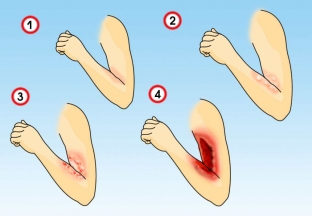Burns – This is the type of damage that is quite common in everyday life. Use of sparklers, fireworks, candles and hot liquids – all of which could theoretically lead to thermal damage. Unfortunately, not many people know that the timely and correct provision of first aid in case of a burn is the key to successful treatment of such an injury in the future.
How to provide first aid for burns - read on estet-portal.com.
First aid for burns
Thermal injury is one of the most traumatic and life-threatening situations. A burn is tissue damage caused by heat, corrosive liquids, or electrical current. Depending on the damaging factor, burns are divided into thermal, chemical, radiation and electrical burns. Fireworks, sparklers and firecrackers are the etiological factors of thermal burns, and situations of such trauma, unfortunately, are quite common.
Thermal damage can be accompanied by severe tissue damage and even lead to a state of shock. Information on how to properly provide first aid for burns is very relevant for each person.
Burn care:
- First aid for burns should be provided according to the degree of injury;
- Algorithm for providing first aid for burns.
First aid for burns should be provided according to the degree of injury
All burns, depending on the volume and depth of thermal tissue damage, are divided into 4 degrees:
- I degree burn – at this degree, only the superficial layers of the skin are damaged. Visually, with such a burn, a picture of aseptic inflammation is observed: the damaged tissues are edematous and hyperemic. The pain syndrome is expressed slightly.
- In II degree burns, there is deeper skin damage with a pronounced exudative inflammatory process. The damaged areas are also hyperemic and edematous, tense blisters appear on them, filled with a clear or slightly yellowish liquid.

Often, proper first aid for first- and second-degree burns is sufficient and the patient does not require hospitalization.
- At III A degree, necrosis of the affected tissues is observed, but the stratum corneum of the skin is partially preserved. Edema extends to the entire thickness of the skin, a dry or moist scab forms at the site of injury. Blisters with liquid also form, but most of them are destroyed, the bottom of the wound is pink and moist.
- III B degree – this is a deep thermal lesion over the entire thickness of the skin with a partial capture of subcutaneous fat. A scab forms on the damaged area, the blisters are filled with hemorrhagic contents. A sharp decrease in pain sensitivity is characteristic.
- IV degree burn is characterized by deep damage not only to the skin and subcutaneous fat, but also to the involvement of fascia, muscles and even bones into the pathological process.
Algorithm for first aid for burns
There is a first aid algorithm for burns, strict adherence to which helps to provide the most correct assistance and prevent serious complications:
- The first step is to stop exposure to the traumatic agent.
- Burned surfaces must be cooled: for this purpose, the damaged area of the skin should be placed under cold running water for at least 10-15 minutes.
- It is necessary to eliminate the pain syndrome: for this it is recommended to use local and general painkillers.
- The affected surface must be properly treated: the damaged area is closed with a sterile dressing, abundantly moistened with an antiseptic solution. You can also treat the skin with special topical preparations that help eliminate pain and properly heal affected tissues.
With timely and correct first aid for burns of the 1st and 2nd degree, qualified medical care may not be needed. For deeper burns, hospitalization of the patient is mandatory!






Add a comment